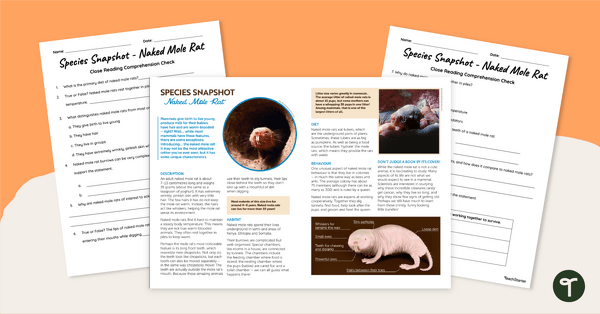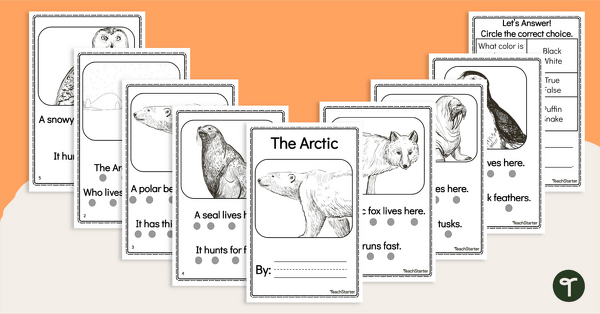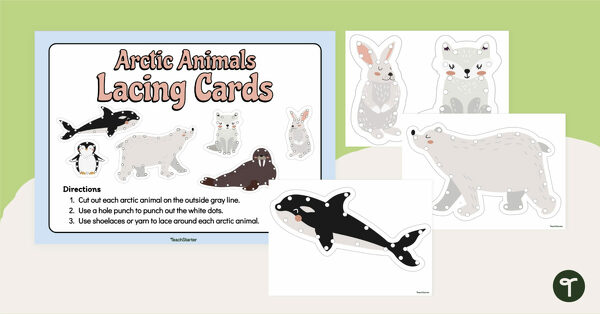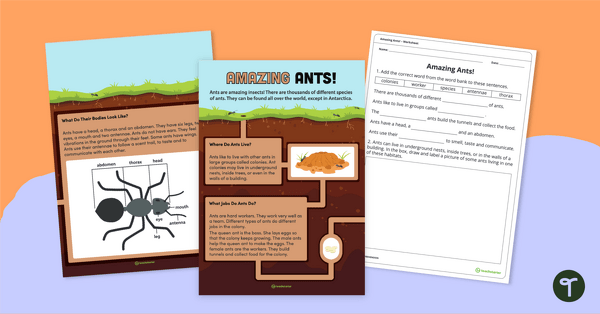Habitats and Ecosystems Teaching Resources
Explore habitat activities, ecosystem worksheets and more, all created by teachers for your lesson planning needs and aligned with the Australian science curriculum.
This extensive collection of teacher resources includes everything you need to teach your students about the places that animals call home around the globe, including rainforests, bushland, deserts, marine ecosystems and more.
Best of all, each printable and digital resource has been carefully reviewed by a member of our teacher team to ensure it's ready to be used in your classroom!
New to teaching about habitats and ecosystems in the primary classroom, or just looking for some fresh ways to engage your students on the topics? Read on for a primer from our teacher team, including a handy definitions for kids on each topic, plus a breakdown of the difference between these two important science terms.
What Is a Habitat? A Definition for Kids
Do you need a quick and easy way to explain the meaning of habitat to your students? Our teacher team has created a definition you can use in the classroom to do just that!
A habitat is a place where plants and animals live. It provides all of the things that they need to survive, like food, water and shelter.
5 Habitat Examples for Kids to Share in Your Classroom
This definition is a good starting point, but perhaps you're looking for a handy list of habitat examples you can share? We've got you covered with that too!
Please note that this list includes five of the planet's major habitats. Some scientists list as many as 16, however this list includes those our students are most likely to need to know about in primary school.
- Desert — The desert habitat is known for its dry and hot conditions, where animals such as the camel and plants such as cacti thrive. Some examples include the Gobi Desert in China and the Sahara Desert in Africa.
- Marine — Also known as the aquatic habitat, marine is larger of all habitats on the planet. Rivers, lakes, streams and, of course, the five oceans on planet Earth provide homes for a variety of marine animals live — from fish to whales to coral and much more.
- Polar — This habitat is found on the two ends of the earth, called the North and South Poles. Plants and animals that live in the polar habitat have adapted to its extreme cold temperatures.
- Forest – The forest habitat makes up nearly a third of the world's landmass. This habitat can be broken down into different types of forests, including the coniferous forests, coastal forests and tropical rainforests. The latter are known for being warm and very moist — just as the name implies, this habitat gets a lot of rain! The most famous of the world's rainforests is the Amazon which covers 6.7 million square kilometres.
- Bushland — One of the largest habitats in the world, bushland typically has moderate to warm weather and plenty of grass for animals to graze on.
What Is an Ecosystem? A Kid-Friendly Definition
We've covered the meaning of habitat, but what about ecosystem? Here's a definition from our teacher team to use in the classroom:
An ecosystem is a community made up of living organisms and nonliving things in a particular area. For example, an ecosystem can include plants, animals and microorganisms that are all living, as well as soil, water and sunlight, which are not.
The living and nonliving things in an ecosystem interact with each other and are interdependent.

Ecosystem vs. Habitat — What's the Difference?
These two science concepts are clearly interrelated, which can be confusing for students. So let's outline the differences.
Habitats
Kids can think of a habitat as a specific place where certain plants and animals live. A habitat is a home, and it's where those plants and animals have everything they need to survive — sort of like the things that students might find in the place where they live. There is shelter, food and water.
Ecosystems
On the other hand, it can be helpful for students to remember that an ecosystem is like a big, interconnected community of habitats.
An ecosystem also goes beyond just plant and animal life.
This larger system includes both living (plants and animals) and non-living (air, water) things. It also includes all the interactions and relationships between the living and non-living things within it.
- Plus Plan

Penguin Adaptations - Year 3 Reading Comprehension
Explore the fascinating world of penguins and their adaptations with our set of printable Year 3 Reading Comprehension worksheets.
- Plus Plan

Naked Mole Rat - Reading Comprehension Worksheets
Read and learn facts about the naked mole rat with a printable reading comprehension worksheet pack for year 4 and 5.
- Free Plan

Map of the World's Climate Zones
Display this climate zone map in your classroom while teaching about the 6 climate types.
- Plus Plan

Helpful Honey Bees Worksheet Pack - Year 2 Comprehension
Read and learn about honey bees with a Printable Honey Bees Worksheet Pack for year 2.
- Plus Plan

Australian Endangered Species Snapshots – Comprehension Worksheet
Explore some Australian endangered species with your students using this set of reading passages with comprehension questions.
- Plus Plan

Human Innovation and Environmental Conservation Teaching Slides
Teach your students how human innovation is helping conserve the environment with this teaching presentation perfect for National Science Week 20204.
- Plus Plan

Ecosystem Poster Pack
Introduce your students to the different types of ecosystems with a set of printable Ecosystem posters.
- Plus Plan

Would You Rather? Animal Adaptations Game
Discuss and debate the best animal adaptations with the Would You Rather? Animal Adaptation game.
- Plus Plan

Desert Animal Adaptations - Trading Card Templates
Discover amazing desert animals’ adaptations and display your learning with printable animal trading card templates.
- Plus Plan

Animals that Use Camouflage - Fact File Cards
Discover animals that use camouflage to survive with these printable Animal Fact File cards.
- Free Plan

Plant and Animal Adaptations – Word Wall Vocabulary
Build scientific vocabulary skills with a printable display of words relating to plant and animal adaptations.
- Plus Plan

Earth Watch: Protecting Native Plants and Animals – Comprehension Worksheet
Build comprehension skills and learn about human impact on ecosystems with a reading passage and worksheets.
- Free Plan

Arctic Animals Booklet - Science Reader
Learn about polar animals and build comprehension skills with a Year 2 Arctic animal book.
- Plus Plan

Climate Zones of the World – Poster Pack
Learn about different climate types with this set of 6 printable posters.
- Plus Plan

Science Sparks - Year 4 Science Activities for Fast Finishers
Give your students a little science boost with Science Sparks 4 – our newest set of fast finisher science activities for Year 4!
- Plus Plan

Animals and Their Habitats - Cut and Match Worksheets
Match animals with their habitats with a set of cut and paste worksheets.
- Plus Plan

What Do Living Things Need to Survive? PowerPoint
Teach your students what living things need to survive with an engaging, interactive teaching slide deck.
- Plus Plan

Marine Ecosystem Poster
A poster explaining Marine Ecosystems.
- Plus Plan

Endangered Species Research Flipbook
Get your students to research an endangered species using this easy-to-compile flipbook scaffold.
- Free Plan

Illustrated Ocean Animals Word Wall Cards
Introduce your students to the amazing animals in the sea with an illustrated ocean animal word wall.
- Plus Plan

Who Would Win? - Plant Adaptations Interactive Game
Identify plants and plant adaptations that allow for survival in different environments with an exciting “Who Would Win?” showdown game!
- Plus Plan

European Ecosystem Project
Explore the natural environment of Europe with this engaging European Ecosystem project.
- Plus Plan

Biodiversity in a Habitat – Inquiry-Based Project
Use this biodiversity project to teach your students about the importance of species survival to life on Earth.
- Plus Plan

Australian Habitat Preservation – Inquiry-Based Project
Use this habitat preservation project to teach your students about how to help conserve a threatened Australian environment for future generations.
- Plus Plan

Animals and Their Habitats - Cut and Paste Worksheets
Match the animals and their habitats with a pack of printable cut-and-paste worksheets.
- Free Plan

Wildlife Conservation Vocabulary Words
Build academic vocabulary with a printable Animal Conservation word wall.
- Plus Plan

Preschool Polar Animal Lacing Cards
Help your students develop fine motor skills with a set of Preschool Polar Animals lacing cards.
- Plus Plan

Amazing Ants! – Comprehension Worksheet Year 2
Review reading skills with comprehension worksheet for an article about ants from the Year 2 magazine .
- Free Plan

Ocean & Marine Word Wall Vocabulary
64 marine life word wall vocabulary cards.
- Free Plan

Desert Word Wall Vocabulary
Spark discussion and build academic vocabulary with a desert related vocabulary word wall.
- Plus Plan

How Does the Environment Affect Plants? Science Experiment
Investigate the effects of the environment on plant life with a no-cut printable science experiment mini-book.
- Plus Plan

Animals and Their Habitats- Interactive Animal Habitat Game
Help a lost polar bear (and his friends) return to the correct habitat with an interactive animal habitat game.
- Habitats and Ecosystems Posters
- Habitats and Ecosystems Worksheets
- Habitats and Ecosystems for Foundation Year
- Habitats and Ecosystems for Year 1
- Habitats and Ecosystems for Year 2
- Habitats and Ecosystems for Year 3
- Habitats and Ecosystems for Year 4
- Habitats and Ecosystems for Year 5
- Habitats and Ecosystems for Year 6